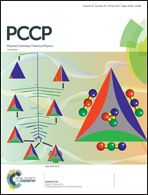Gas-phase structure of 1,8-bis[(trimethylsilyl)ethynyl]anthracene: cog-wheel-type vs. independent internal rotation and influence of dispersion interactions†
Abstract
The gas-phase structure of 1,8-bis[(trimethylsilyl)ethynyl]anthracene (1,8-BTMSA) was determined by a combined gas electron diffraction (GED)/mass spectrometry (MS) experiment as well as by quantum-chemical calculations (QC). DFT and dispersion corrected DFT calculations (DFT-D3) predicted two slightly different structures for 1,8-BTMSA concerning the mutual orientation of the two –C–C![[triple bond, length as m-dash]](https://www.rsc.org/images/entities/char_e002.gif) C–SiMe3 units: away from one another or both bent to the same side. An attempt was made to distinguish these structures by GED structural analysis. To probe the structural rigidity, a set of Born–Oppenheimer molecular dynamics (BOMD) calculations has been performed at the DFT-D level. Vibrational corrections Δr = ra − re were calculated by two BOMD approaches: a microcanonically (NVE) sampled ensemble of 20 trajectories (BOMD(NVE)) and a canonical (NVT) trajectory thermostated by the Noose–Hoover algorithm (BOMD(NVT)). In addition, the conventional approach with both, rectilinear and curvilinear approximations (SHRINK program), was also applied. Radial distribution curves obtained with models using both MD approaches provide a better description of the experimental data than those obtained using the rectilinear (SHRINK) approximation, while the curvilinear approach turned out to lead to physically inacceptable results. The electronic structure of 1,8-BTMSA was investigated in terms of an NBO analysis and was compared with that of the earlier studied 1,8-bis(phenylethynyl)anthracene. Theoretical and experimental results lead to the conclusion that the (trimethylsilyl)ethynyl (TMSE) groups in 1,8-BTMSA are neither restricted in rotation nor in bending at the temperature of the GED experiment.
C–SiMe3 units: away from one another or both bent to the same side. An attempt was made to distinguish these structures by GED structural analysis. To probe the structural rigidity, a set of Born–Oppenheimer molecular dynamics (BOMD) calculations has been performed at the DFT-D level. Vibrational corrections Δr = ra − re were calculated by two BOMD approaches: a microcanonically (NVE) sampled ensemble of 20 trajectories (BOMD(NVE)) and a canonical (NVT) trajectory thermostated by the Noose–Hoover algorithm (BOMD(NVT)). In addition, the conventional approach with both, rectilinear and curvilinear approximations (SHRINK program), was also applied. Radial distribution curves obtained with models using both MD approaches provide a better description of the experimental data than those obtained using the rectilinear (SHRINK) approximation, while the curvilinear approach turned out to lead to physically inacceptable results. The electronic structure of 1,8-BTMSA was investigated in terms of an NBO analysis and was compared with that of the earlier studied 1,8-bis(phenylethynyl)anthracene. Theoretical and experimental results lead to the conclusion that the (trimethylsilyl)ethynyl (TMSE) groups in 1,8-BTMSA are neither restricted in rotation nor in bending at the temperature of the GED experiment.
![Graphical abstract: Gas-phase structure of 1,8-bis[(trimethylsilyl)ethynyl]anthracene: cog-wheel-type vs. independent internal rotation and influence of dispersion interactions](/en/Image/Get?imageInfo.ImageType=GA&imageInfo.ImageIdentifier.ManuscriptID=C7CP01781B&imageInfo.ImageIdentifier.Year=2017)


 Please wait while we load your content...
Please wait while we load your content...